Investigations on Transfer of Pathogens between Foster Cows and Calves during the Suckling Period
Abstract
:Simple Summary
Abstract
1. Introduction
2. Materials and Methods
2.1. Farm and Management
2.2. Study Design and Data Collection
2.3. Quarter Milk Samples
2.4. Oral Cavity Swabs
2.5. Laboratory Analyses
2.5.1. Quarter Milk Samples
2.5.2. Oral Cavity Swabs
2.5.3. Strain Comparisons
2.6. Statistical Analyses
3. Results
3.1. Numbers of Cows, Udder Quarters and Calves
3.2. Quarter Milk Samples
3.3. Oral Cavity Swabs
3.4. Pathogen Matches between Foster Cows and Calves
3.5. Pathogen Matches between Dam and Calf
4. Discussion
4.1. Pathogens Detected in the Oral Cavities of Calves
4.2. Matching Pathogens between Cow and Calves
4.2.1. Results of Strain Typing
4.2.2. Other Mastitis-Associated Pathogens
4.3. Consequences for Udder Health, Calf Health and Internal Biosecurity
5. Conclusions
Supplementary Materials
Author Contributions
Funding
Institutional Review Board Statement
Data Availability Statement
Acknowledgments
Conflicts of Interest
References
- Lund, V. Natural living—A precondition for animal welfare in organic farming. Livest. Sci. 2006, 100, 71–83. [Google Scholar] [CrossRef] [Green Version]
- Busch, G.; Weary, D.M.; Spiller, A.; von Keyserlingk, M.A.G. American and German attitudes towards cow-calf separation on dairy farms. PLoS ONE 2017, 12, e0174013. [Google Scholar] [CrossRef] [Green Version]
- Placzek, M.; Christoph-Schulz, I.; Barth, K. Public attitude towards cow-calf separation and other common practices of calf rearing in dairy farming—review. Org. Agric. 2021, 11, 41–50. [Google Scholar] [CrossRef]
- Beaver, A.; Meagher, R.K.; von Keyserlingk, M.A.G.; Weary, D.M. Invited review: A systematic review of the effects of early separation on dairy cow and calf health. J. Dairy Sci. 2019, 102, 5784–5810. [Google Scholar] [CrossRef]
- Sirovnik, J.; Barth, K.; de Oliveira, D.; Ferneborg, S.; Haskell, M.J.; Hillmann, E.; Jensen, M.B.; Mejdell, C.M.; Napolitano, F.; Vaarst, M.; et al. Methodological terminology and definitions for research and discussion of cow-calf contact systems. J. Dairy Res. 2020, 87, 108–114. [Google Scholar] [CrossRef]
- Johnsen, J.F.; Zipp, K.; Kälber, T.; de Passillé, A.M.; Knierim, U.; Barth, K.; Mejdell, C.M. Is rearing calves with the dam a feasible option for dairy farms?—Current and future research. Appl. Anim. Behav. Sci. 2015, 181, 1–11. [Google Scholar] [CrossRef] [Green Version]
- Wagenaar, J.P.T.M.; Langhout, J. Practical implications of increasing ‘natural living’ through suckling systems in organic dairy calf rearing. NJAS Wagening. J. Life Sci. 2007, 54, 375–386. [Google Scholar] [CrossRef] [Green Version]
- Loberg, J. Behaviour of Foster Cows and Calves in Dairy Production; Diss, Faculty of Veterinary Medicine and Animal Science, Department of Animal Environment and Health, Swedish University of Agricultural Sciences: Skara, Sweden, 2007; pp. 1652–6880. Available online: https://pub.epsilon.slu.se/1636/ (accessed on 2 August 2021).
- Walsh, J.P. Milk secretion in machine-milked and suckled cows. Isr. J. Agric. Res. 1974, 13, 77–89. [Google Scholar]
- Margerison, J.K.; Preston, T.R.; Philips, C.J.C. Restricted suckling of tropical dairy cows by their own calf or other cow’s calves. J. Anim. Sci. 2002, 80, 1663–1670. [Google Scholar] [CrossRef] [PubMed]
- Rigby, C.; Ugarte, J.; Boucourt, R. Rearing dairy calves by restricted suckling. VII. Effect on mastitis development caused by Staphylococcus aureus. Cuban J. Agric. Sci. 1976, 10, 35–40. [Google Scholar]
- Fulkerson, W.J.; Hooley, R.D.; Findlay, J.K. Improvement in milk production of first calf heifers by multiple suckling. Aust. J. Agric. Res. 1978, 29, 351–357. [Google Scholar] [CrossRef]
- Bar-Peled, U.; Maltz, E.; Bruckental, I.; Folman, Y.; Kali, Y.; Gacitua, H.; Lehrer, A.R.; Knight, C.H.; Robinson, B.; Voet, H.; et al. Relationship Between Frequent Milking or Suckling in Early Lactation and Milk Production of High Producing Dairy Cows. J. Dairy Sci. 1995, 78, 2726–2736. [Google Scholar] [CrossRef]
- Klein, L.A.; Kleckner, A.L. Possibility of the transmission of mastitis streptococci by suckling calves. Vet. Extens. Q. 1941, 82, 13–18. [Google Scholar]
- Schalm, O.W. Streptococcus agalactiae in the udders of heifers at parturition traced to sucking among calves. Cornell Vet. 1942, 32, 49–60. [Google Scholar]
- Barnum, D.A. A herd outbreak of mastitis caused by Pasteurella Multocida. Can. J. Comp. Med. 1954, 18, 113–119. [Google Scholar]
- Špinka, M.; Illmann, G. Suckling behaviour of young dairy calves with their own and alien mothers. Appl. Anim. Behav. Sci. 1992, 33, 165–173. [Google Scholar] [CrossRef]
- Kilgour, R. Some observations on the suckling activity of calves on nurse cows. Proc. N. Z. Soc. Anim. Prod. 1972, 32, 132–136. [Google Scholar]
- German Veterinary Medical Association. Leitlinien zur Labordiagnostik der Mastitis—Probenahme und Mikrobiologische Untersuchung, 3rd ed.; German Veterinary Medical Association: Gießen, Germany, 2018. [Google Scholar]
- Watts, J.L.; Salomon, S.A.; Yancey, J.R., Jr. Use of modified Rambach agar to differentiate Streptococcus uberis from other mastitis streptococci. J. Dairy Sci. 1993, 76, 1740–1743. [Google Scholar] [CrossRef]
- Theel, E.S.; Schmitt, B.H.; Hall, L.; Cunningham, S.A.; Walchak, R.C.; Patel, R.; Wengenack, N.L. Formic Acid-Based Direct, On-Plate Testing of Yeast and Corynebacterium Species by Bruker Biotyper Matrix-Assisted Laser Desorption Ionization-Time of Flight Mass Spectrometry. J. Clin. Microbiol. 2012, 50, 3093–3095. [Google Scholar] [CrossRef] [PubMed] [Green Version]
- Williams, J.G.K.; Kubelik, A.R.; Livak, K.J.; Rafalski, J.A.; Tingey, S.V. DNA polymorphisms amplified by arbitrary primers are useful as genetic markers. Nucleic Acid Res. 1990, 18, 6531–6535. [Google Scholar] [CrossRef] [Green Version]
- Vogel, L.; Jones, G.; Triep, S.; Koek, A.; Dijkshoorn, L. RAPD typing of Klebsiella pneumoniae, Klebsiella oxytoca, Serratia marcescens and Pseudomonas aeruginosa isolates using standardized reagents. Clin. Microbiol. Infect. 1999, 5, 270–276. [Google Scholar] [CrossRef] [PubMed] [Green Version]
- Gillespie, B.E.; Jayarao, B.M.; Pankey, J.W.; Oliver, S.P. Subtyping of Streptococcus dysgalactiae and Streptococcus uberis isolated from bovine mammary secretions by DNA fingerprinting. J. Vet. Med. 1998, 45, 585–593. [Google Scholar] [CrossRef]
- Daminani, G.; Telecco, S.; Comincini, S.; Sironi, M.; Carretto, E.; Marone, P. Comparison of an improved RAPD fingerprinting with different typing methods for discriminating clinical isolates of Staphylococcus spp. Eur. J. Cardiovasc. Prev. Rehabil. 1996, 12, 163–169. [Google Scholar] [CrossRef]
- Hijazin, M.; Sammra, O.; Ulbegi-Mohyla, H.; Nagib, S.; Alber, J.; Lämmler, C.; Kämpfer, P.; Glaeser, S.P.; Busse, H.J.; Kassmannhuber, J.; et al. Arcanobacterium phocisimile sp. nov., isolated from harbour seals. Int. J. Syst. Evol. Microbiol. 2013, 63, 2019–2024. [Google Scholar] [CrossRef] [PubMed]
- Wente, N.; Klocke, D.; Mohr, E.; Krömker, V. Mikrobiologische Mastitisdiagnostik für jeden Anlass. Prakt. Tierarzt. 2019, 100, 1067–1075. [Google Scholar] [CrossRef]
- White, D.G.; Harmon, R.J.; Matos, J.E.S.; Langlois, B.E. Isolation and Identification of Coagulase-Negative Staphylococcus Species from Bovine Body Sites and Streak Canals of Nulliparous Heifers. J. Dairy. Sci. 1989, 72, 1886–1892. [Google Scholar] [CrossRef]
- Adkins, P.R.F.; Dufour, S.; Spain, J.N.; Calcutt, M.J.; Reilly, T.J.; Stewart, G.C.; Middleton, J.R. Molecular characterization of non-aureus Staphylococcus spp. from heifer intramammary infections and body sites. J. Dairy Sci. 2018, 101, 5388–5403. [Google Scholar] [CrossRef] [PubMed]
- Devriese, L.A.; De Keyser, H. Prevalence of different species of coagulase-negative staphylococci on teats and in milk samples from dairy cows. J. Dairy Res. 1980, 47, 155–158. [Google Scholar] [CrossRef]
- Matos, J.S.; White, D.G.; Harmon, R.J.; Langlois, B.E. Isolation of Staphylococcus aureus from Sites Other than the Lactating Mammary Gland. J. Dairy Sci. 1991, 74, 1544–1549. [Google Scholar] [CrossRef]
- Piessens, V.; Van Coillie, E.; Verbist, B.; Supré, K.; Braem, G.; Van Nuffel, A.; De Vuyst, L.; Heyndrickx, M.; De Vliegher, S. Distribution of coagulase-negative Staphylococcus species from milk and environment of dairy cows differs between herds. J. Dairy Sci. 2011, 94, 2933–2944. [Google Scholar] [CrossRef]
- De Visscher, A.; Supré, K.; Haesebrouck, F.; Zadoks, R.N.; Pierssens, V.; Van Coillie, E.; Piepers, S.; De Vliegher, S. Further evidence for the existence of environmental and host-associated species of coagulase-negative staphylococci in dairy cattle. Vet Microbiol 2014, 172, 466–474. [Google Scholar] [CrossRef]
- Devriese, L.A.; Vandamme, P.; Collins, M.D.; Alvarez, N.; Pot, B.; Hommez, J.; Butaye, P.; Haesebrouck, F. Streptococcus pluranimalium sp. nov. from cattle and other animals. Int. J. Syst. Evol. Microbiol. 1999, 49, 1221–1226. [Google Scholar] [CrossRef] [PubMed] [Green Version]
- Obiger, G. Die Streptokokkenflora in den bovinen Tonsillen. Z. Hyg. Infekt. Med. Mikrobiol. Immunol. Virol. 1962, 148, 405–411. [Google Scholar] [CrossRef]
- Daleel, E.E.; Frost, A.J. Some observations on the bacterial flora of the bovine tonsil. Br. Vet. J. 1967, 123, 232–236. [Google Scholar] [CrossRef]
- Jørgensen, H.J.; Nordstoga, A.B.; Sviland, S.; Zadoks, R.N.; Sølverød, L.; Kvitle, B.; Mørk, T. Streptococcus agalactiae in the environment of bovine dairy herds—Rewriting the textbooks? Vet. Microbiol. 2016, 184, 64–72. [Google Scholar] [CrossRef] [PubMed]
- Milanov, D.; Aleksić, N.; Todorović, D.; Bugarski, D. Pasteurella multocida mastitis in cow: Case report. Vet. Glas. 2017, 71, 117–122. [Google Scholar] [CrossRef] [Green Version]
- Turni, C.; Dayao, D.; Aduriz, G.; Cortabarria, N.; Tejero, C.; Ibabe, J.C.; Singh, R.; Blackall, P. A Pasteurella multocida strain affecting nulliparous heifers and calves in different ways. Vet. Microbiol. 2016, 195, 17–21. [Google Scholar] [CrossRef] [Green Version]
- Davidson, I. Observations on the Pathogenic Staphylococci in a Dairy Herd During a Period of Six Years. Res. Vet. Sci. 1961, 2, 22–40. [Google Scholar] [CrossRef]
- Pettersen, K.E. Mastitis among heifers before calving. In Jurhelse Hos Geit Og Ku; Norges Veterinaerhogskole: Oslo, Norway, 1981; Available online: https://ezproxy.tiho-hannover.de:2259/login.aspx?drect=true&db=lah&AN=19820479785&lang=de&site=eds-live (accessed on 9 August 2021).
- Capurro, A.; Aspán, A.; Ericsson Unnerstad, H.; Persson Waller, K.; Artusson, K. Identification of potential sources of Staphylococcus aureus in herds with mastitis problems. J. Dairy Sci. 2010, 93, 180–191. [Google Scholar] [CrossRef] [PubMed]
- Tenhagen, B.A.; Koster, G.; Wallmann, J.; Heuwieser, W. Prevalence of mastitis pathogens and their resistance against antimicrobial agents in dairy cows in Brandenburg, Germany. J. Dairy Sci. 2006, 89, 2542–2551. [Google Scholar] [CrossRef] [Green Version]
- Hamel, J.; Zhang, Y.; Wente, N.; Krömker, V. Non-S. aureus staphylococci (NAS) in milk samples: Infection or contamination? Vet. Microbiol. 2020, 242, 108594. [Google Scholar] [CrossRef] [PubMed]
- Staats, J.J.; Feder, I.; Okwumabua, O.; Chengappa, M.M. Streptococcus Suis: Past and Present. Vet. Res. Commun. 1997, 21, 381–407. [Google Scholar] [CrossRef]
- Hommez, J.; Wullepit, J.; Cassimon, P.; Castryck, F.; Ceyssens, K.; Devriese, L.A. Streptococcus suis and other streptococcal species as cause of extramammary infection in ruminants. Vet. Rec. 1988, 123, 626–627. [Google Scholar] [PubMed]
- Okwumabua, O.; Peterson, H.; Hsu, H.-M.; Bochsler, P.; Behr, M. Isolation and partial characterization of Streptococcus suis from clinical cases in cattle. J. Vet. Diagn. Investig. 2017, 29, 160–168. [Google Scholar] [CrossRef] [PubMed] [Green Version]
- Cruz-Colque, J.I.; Devriese, L.A.; Haesebrouck, F. Streptococci and enterococci associated with tonsils of cattle. Lett. Appl. Microbiol. 1993, 16, 72–74. [Google Scholar] [CrossRef] [PubMed]
- Biberstein, E.L. Our understanding of the Pasteurellaceae. Can. J. Vet. Res. 1990, 54, 78–82. [Google Scholar]
- Abb-Schwedler, K.; Maeschli, A.; Boss, R.; Graber, H.U.; Steiner, A.; Klocke, P. Feeding mastitis milk to organic dairy calves: Effect on health and performance during suckling and on udder health at first calving. BMC. Vet. Res. 2014, 10. [Google Scholar] [CrossRef]
- Kälber, T.; Barth, K. Practical implications of suckling systems for dairy calves in organic production systems—A review. Landbauforschung 2014, 64, 45–58. [Google Scholar] [CrossRef]
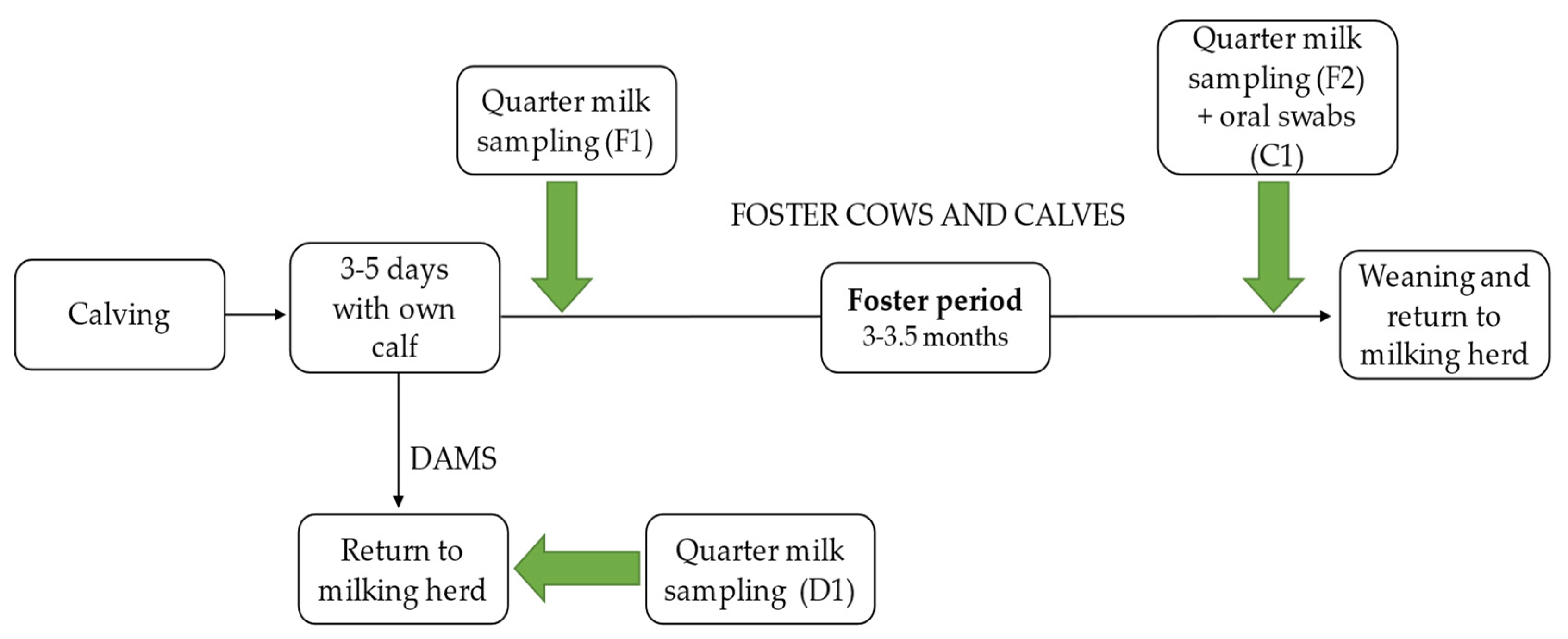
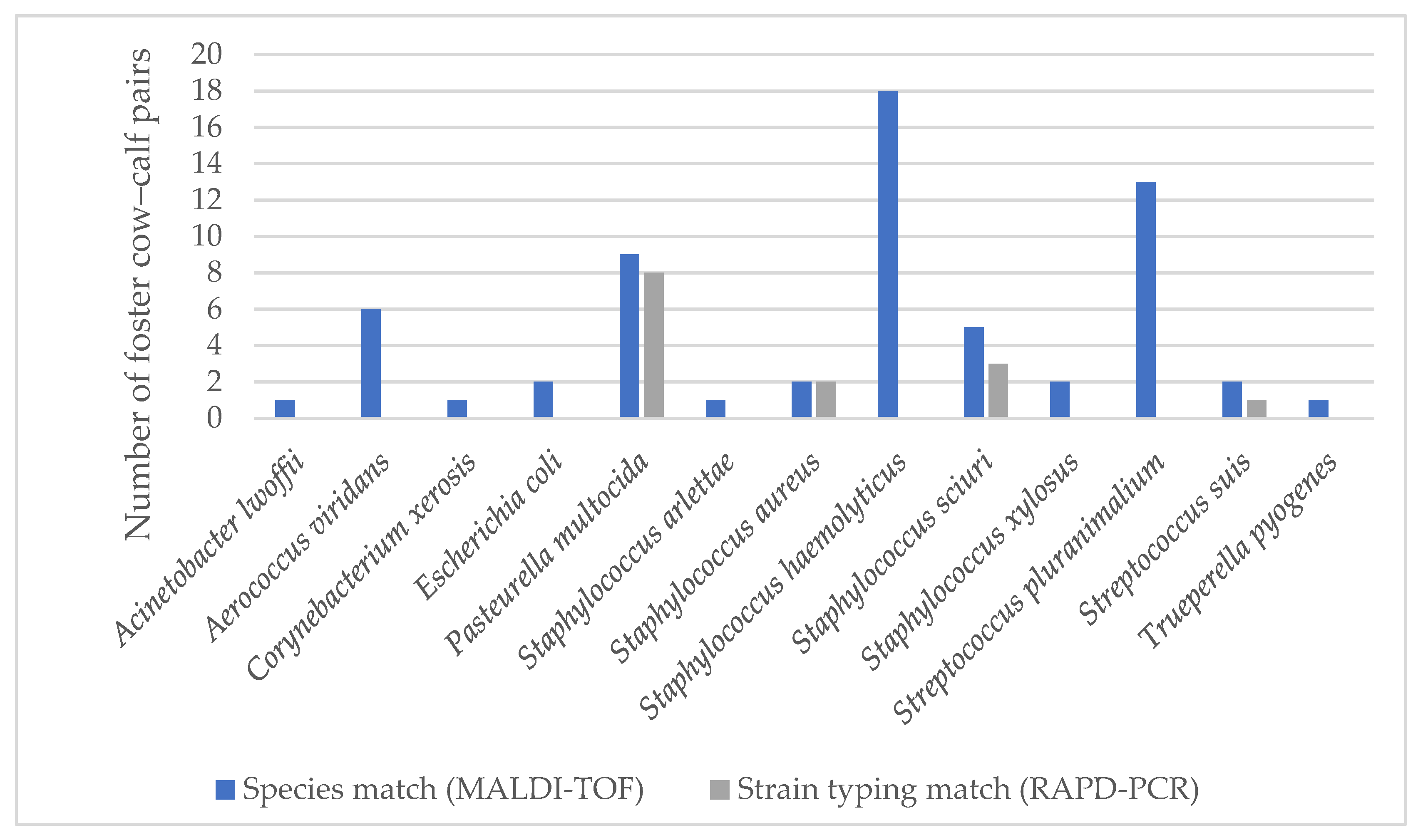
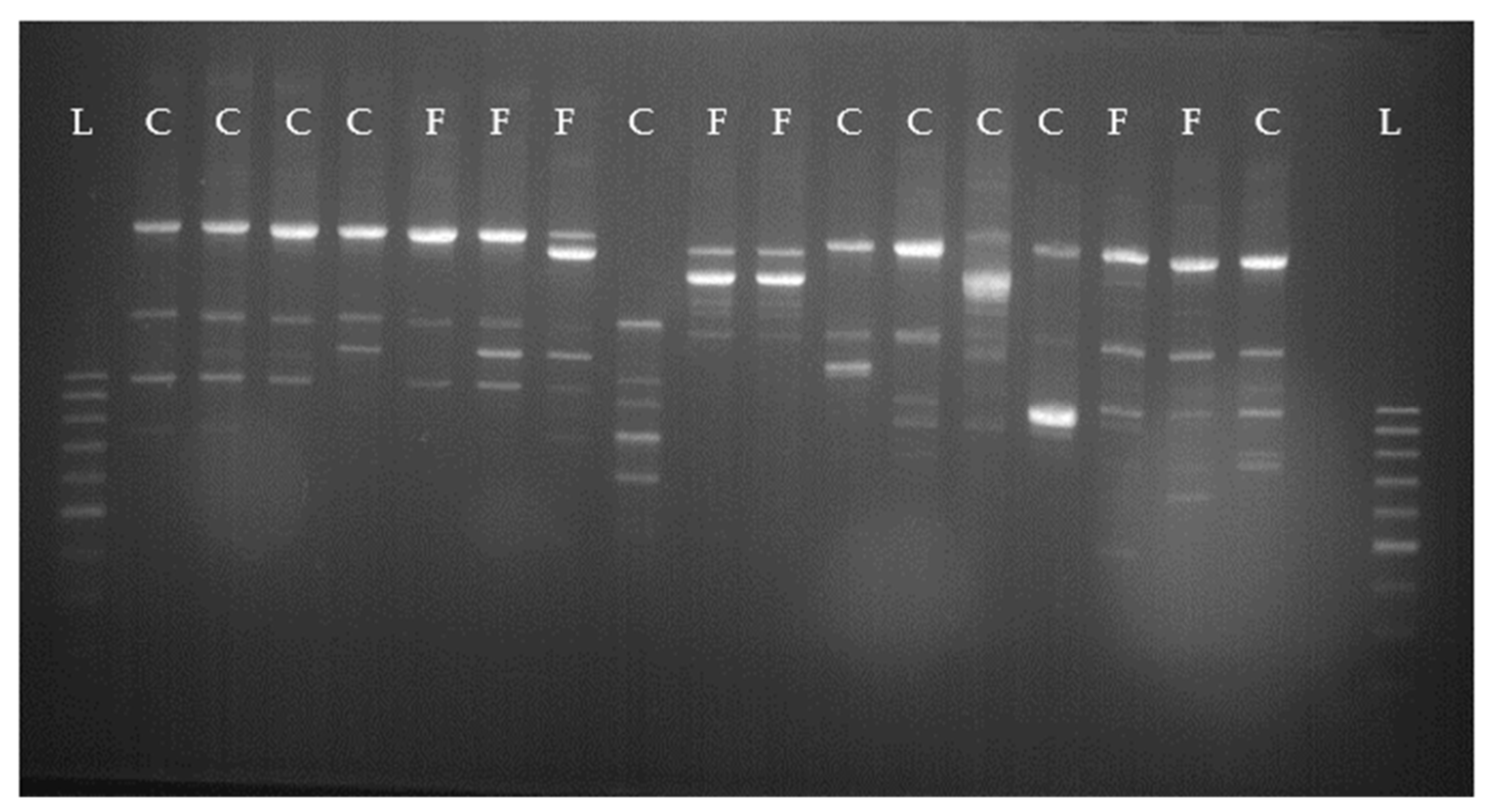
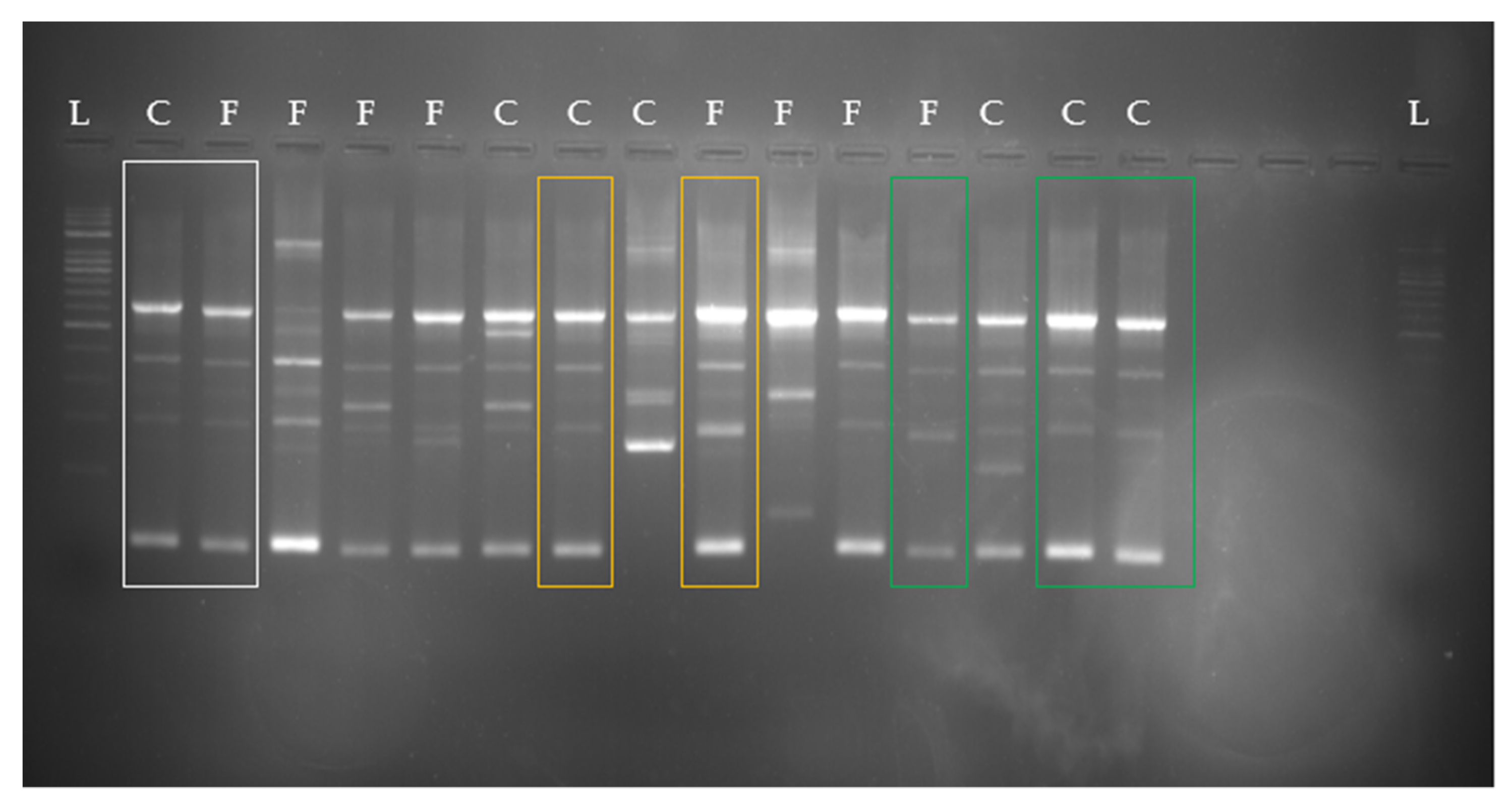
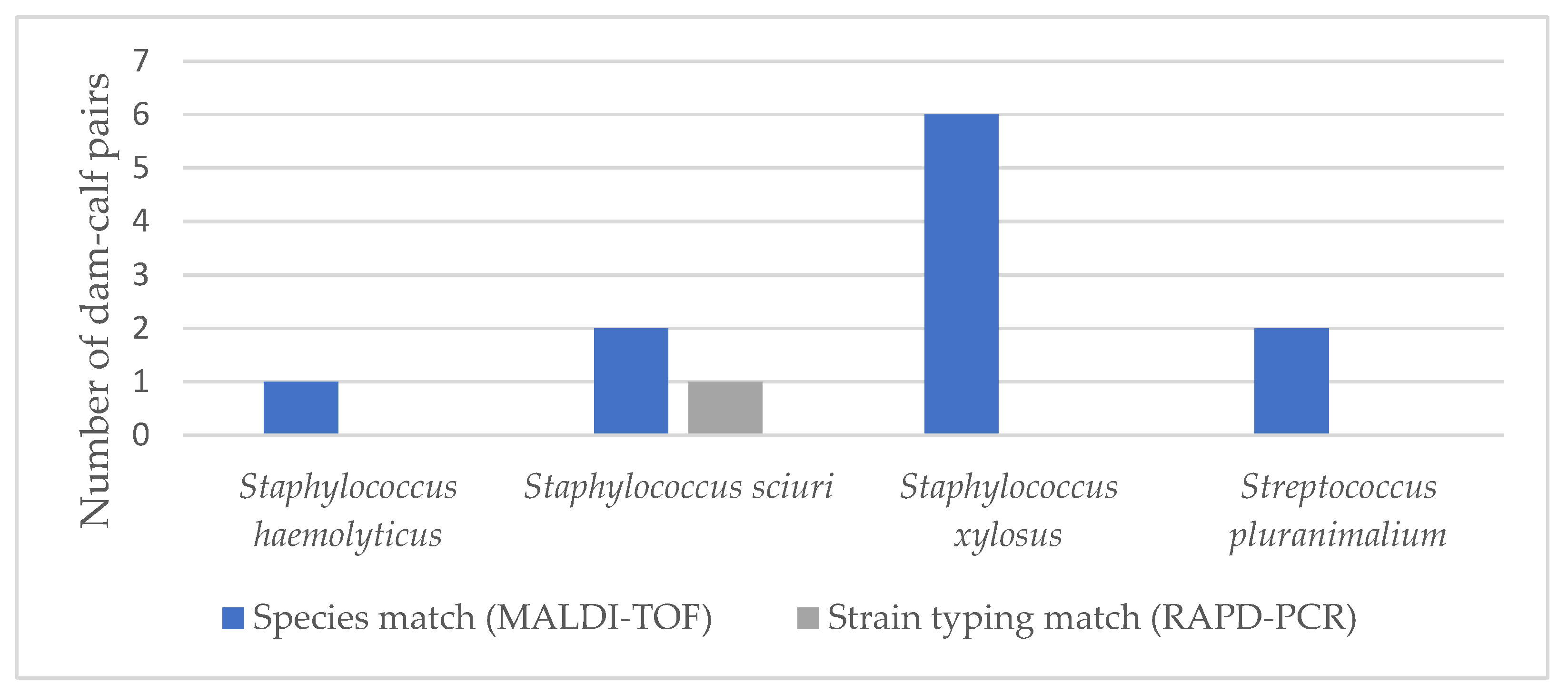
| Pathogen | Number (% 1) of Isolated Pathogens per Sampling (F1, F2, D1) | ||
|---|---|---|---|
| F1 | F2 | D1 | |
| Streptococcus uberis | 1 (0.3) | 2 (0.5) | 4 (0.8) |
| NaS 2 | 29 (7.5) | 24 (6.2) | 86 (17.8) |
| Staphylococcus aureus | 0 (0) | 3 (0.8) | 4 (0.8) |
| Streptococcus dysgalactiae | 0 (0) | 2 (0.5) | 0 (0) |
| Trueperella pyogenes | 0 (0) | 2 (0.5) | 1 (0.2) |
| Escherichia coli | 8 (2.1) | 0 (0) | 0 (0) |
| Coliforms | 5 (1.3) | 0 (0) | 0 (0) |
| Klebsiella spp. | 2 (0.5) | 1 (0.3) | 1 (0.2) |
| Bacillus spp. | 3 (0.8) | 0 (0) | 1 (0.2) |
| Corynebacterium spp. | 37 (9.6) | 50 (13) | 31 (6.4) |
| Enterococcus spp. | 4 (1.0) | 2 (0.5) | 0 (0) |
| Pseudomonas spp. | 2 (0.5) | 0 (0) | 0 (0) |
| Other Streptococci | 3 (0.8) | 4 (1.0) | 2 (0.4) |
| Lactic acid bacteria | 6 (1.6) | 0 (0) | 0 (0) |
| Pasteurella spp. | 0 (0) | 13 (3.4) | 0 (0) |
| Others 3 | 2 (0.5) | 7 (1.9) | 1 (0.2) |
| Mixed | 19 (4.9) | 12 (3.1) | 16 (3.3) |
| Contaminated 4 | 22 (5.7) | 38 (9.9) | 76 (15.7) |
| In total | 121 (31.4) | 122 (31.7) | 147 (30.4) |
| No specific growth 5 | 242 (62.9) | 225 (58.4) | 260 (53.8) |
| Pathogen/Pathogen Group | n (%) | Pathogen Species (n) |
|---|---|---|
| NaS 1 | 531 (34.3) | Staphylococcus (S.) xylosus (195) |
| S. haemolyticus (107) | ||
| S. sciuri (88) | ||
| S. gallinarum (48) | ||
| S. equorum (32) | ||
| S. arlettae (18) | ||
| S. vitulinus (18) | ||
| S. chromogenes (9) | ||
| S. auricularis (5) | ||
| S. lentus (4) | ||
| S. epidermidis (3) | ||
| S. succinus (2) | ||
| S. cohnii (1) | ||
| S. gallinaceus (1) | ||
| Streptococci | 418 (27) | Streptococcus (Sc.) pluranimalium (271) |
| Sc. suis (64) | ||
| Sc. ovis (16) | ||
| Sc. orisratti (12) | ||
| Sc. henryi (8) | ||
| Sc. minor (7) | ||
| Sc. gallolyticus (6) | ||
| Sc. sanguinis (6) | ||
| Sc. gallinaceus (5) | ||
| Sc. oralis (5) | ||
| Sc. devriesei (4) | ||
| Sc. lutetiensis (3) | ||
| Sc. hyovaginalis (2) | ||
| Sc. thoraltensis (2) | ||
| Sc. canis/Sc. dysgalactiae (1) | ||
| Sc. gallinarum (1) | ||
| Sc. infantarius (1) | ||
| Sc. mitis (1) | ||
| Sc. mitis/oralis/peroralis (1) | ||
| Sc. parasanguinis (1) | ||
| Sc. ratti (1) | ||
| Corynebacterium spp. | 137 (8.9) | Corynebacterium (C.) xerosis (97) |
| C. stationis (9) | ||
| C. glutamicum (8) | ||
| C. camporealensis (5) | ||
| C. freneyi (4) | ||
| C. casei (3) | ||
| C. propinquum (3) | ||
| C. callunae (2) | ||
| C. efficiens (2) | ||
| C. amycolatum (1) | ||
| C. flavescens (1) | ||
| C. stimulans (1) | ||
| C. urealyticum (1) | ||
| Aerococcus viridans | 93 (6) | |
| Rothia nasimurium | 66 (4.3) | |
| Pasteurella multocida | 49 (3.2) | |
| Staphylococcus aureus | 41 (2.6) | |
| Bacillus spp. | 40 (2.6) | Bacillus (B.) pumilus (16) |
| B. altitudinis (8) | ||
| B. subtilis (7) | ||
| B. licheniformis (4) | ||
| B. clausii (3) | ||
| B. subtilis group (2) | ||
| Acinetobacter spp. | 28 (1.8) | Acinetobacter (A.) johnsonii (9) |
| A. pittii (9) | ||
| A. schindleri (4) | ||
| A. lwoffii (2) | ||
| A. spp. (2) | ||
| A. indicus (1) | ||
| Member of A. baumnnii/calcoaceticus complex (1) | ||
| Candida albicans | 20 (1.3) | |
| Enterococcus spp. | 17 (1.1) | Enterococcus (E.) faecium (12) |
| E. casseliflavus (3) | ||
| E. aquimarinus (1) | ||
| E. villorum (1) | ||
| Mannheima spp. | 16 (1) | Mannheimia (M.) haemolytica (10) |
| M. varigena (6) | ||
| Pseudomonas spp. | 11 (0.7) | Pseudomonas (P.) monteilii (4) |
| Member of P. stutzeri group (2) | ||
| P. aeruginosa (1) | ||
| P. extremorientalis (1) | ||
| P. fulva (1) | ||
| P. stutzeri (1) | ||
| P. synxantha (1) | ||
| Trueperella pyogenes | 10 (0.6) | |
| Micrococcus spp. | 9 (0.6) | Micrococcus (M.) luteus (3) |
| M. lylae (6) | ||
| Pantoea agglomerans | 8 (0.5) | |
| Paenibacillus spp. | 7 (0.5) | Paenibacillus (P.) lactis (3) |
| P. spp. (3) | ||
| P. woosongensis (1) | ||
| Escherichia coli | 5 (0.3) | |
| Stenotrophomonas spp. | 5 (0.3) | Stenotrophomonas (S.) maltophilia (3) |
| Member of S. maltophilia (1) | ||
| S. spp. (1) | ||
| Others | 37 (2.4) | Brevibacterium luteolum (1) |
| Cellulosimicrobium cellulans (1) | ||
| Synonym of Cryptococcus neoformans (1) | ||
| Curtobacterium flaccumfaciens (1) | ||
| Desemezia incerta (2) | ||
| Enterobacter cloacae (3) | ||
| Erwinia persicina (1) | ||
| Exiguobacterium spp. (1) | ||
| Glumaticibacter arilaitensis (1) | ||
| Granulicatella adiacens (1) | ||
| Helococcus ovis (1) | ||
| Klebsiella oxytoca (1) | ||
| Kocuria carniphila (4) | ||
| Macrococcus canis (2) | ||
| Microbacterium spp. (4) | ||
| Moraxella boviculi (3) | ||
| Neisseria spp. (3) | ||
| Ochrobacterium intermedium (1) | ||
| Oerskovia tubata (1) | ||
| Psychrobacter spp. (1) | ||
| Serratia marcesens (1) | ||
| Solibacillus silvestris (1) | ||
| Weissella hellenica (1) | ||
| In total | 1548 (100) | |
Publisher’s Note: MDPI stays neutral with regard to jurisdictional claims in published maps and institutional affiliations. |
© 2021 by the authors. Licensee MDPI, Basel, Switzerland. This article is an open access article distributed under the terms and conditions of the Creative Commons Attribution (CC BY) license (https://creativecommons.org/licenses/by/4.0/).
Share and Cite
Köllmann, K.; Wente, N.; Zhang, Y.; Krömker, V. Investigations on Transfer of Pathogens between Foster Cows and Calves during the Suckling Period. Animals 2021, 11, 2738. https://doi.org/10.3390/ani11092738
Köllmann K, Wente N, Zhang Y, Krömker V. Investigations on Transfer of Pathogens between Foster Cows and Calves during the Suckling Period. Animals. 2021; 11(9):2738. https://doi.org/10.3390/ani11092738
Chicago/Turabian StyleKöllmann, Katharina, Nicole Wente, Yanchao Zhang, and Volker Krömker. 2021. "Investigations on Transfer of Pathogens between Foster Cows and Calves during the Suckling Period" Animals 11, no. 9: 2738. https://doi.org/10.3390/ani11092738







